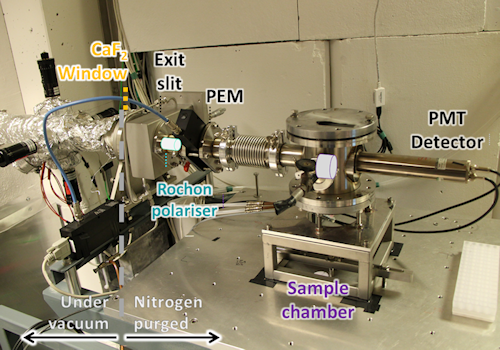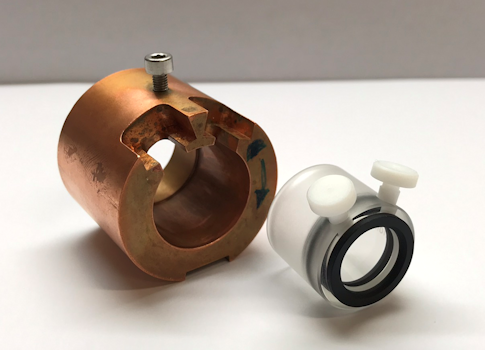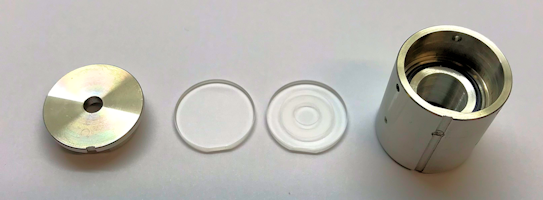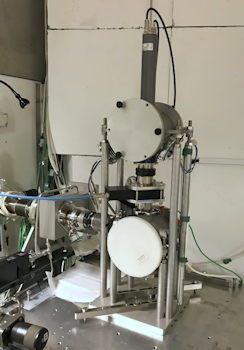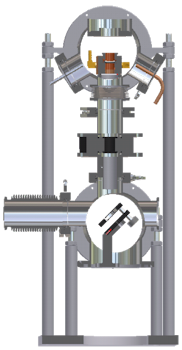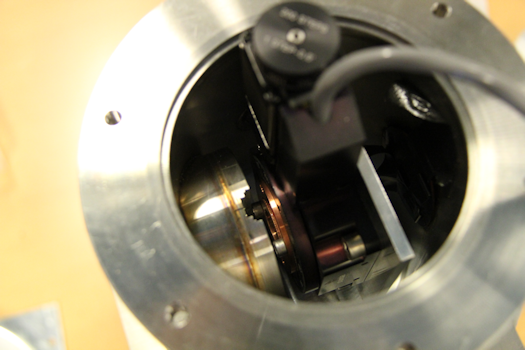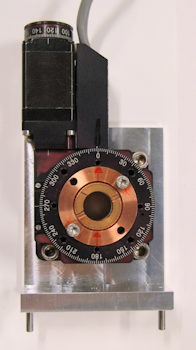The AU-CD beam line on ASTRID2
The SRCD end-stations and sample environments.
The light from the AU-CD beam line passes through a CaF2 window into a nitrogen purged closed system. Common for all available end-stations at the beam line, the light first passes through an exit slit (the size of which can be varied) to be monochromatised and then through a MgF2 Rochon polarizer, to ensure horizontally polarized light. Nitrogen flows from the exit slit chamber through to the end-station. Additional nitrogen flow is set in place in the end-stations, with flow paths optimized for efficient purging of the light path from beam line to detector.
Sample holders
- Closed quartz cells of Hellma type 121.000 QS, with Teflon stoppers, for liquid samples. Typical pathlenght are 0.1, 0.2, 0.5 and 1.0 mm. The 0.1 mm cell may be filled with volumes from about 25 uL to 160 uL.
These cells are well suited for temperature studies, thermal melts, where the temperature is e.g. incremented in steps and the CD spectrum is acquired for each temperature.
The cell holder for these cells are made of copper, with a snug fit between the cell and holder wall for good thermal contact.
- Open quartz cells of Hellma type 124 QS consisting of two plates, one flat and one with a well for the liquid sample. Typical pathlengths are between 10 um and 0.1 mm. The two sandwiched plates are
placed between an O-ring and two Teflon rings, and closed off with a copper screw lid. The Teflon rings prevents the two quartz plates from rotation with respect to each other upon lid closure.
Typical filling volumes for a 0.1 mm cell is 15-20 uL. This sample holder may also be used for solid samples on single quartz or CaF2 plates.
- Highly specialised open CaF2 cells produced on request by Hellma. Pathlenghts range from 2 um to 50 um, and hold volumes down to 2 uL. These cells may be used for highly concentrated samples,
and are mounted in a custom made stainless steel holder, with a rotation free lid.
The standard, dual peltier chamber.
The Double Peltier Chamber (DPC) is the most used end-station on the AU-CD beam line. It features a copper block surrounding the sample holders, heated or cooled with two Peltier elements. Sample temperature may be set between 5 and 85°C. The light exiting the Rochon polarizer passes a Photo Elastic Modulator (PEM) transforming the horizontally polarized light into alternating left and right handed circular polarized light, followed by passing through an aperture at the entrance of the DPC. There are three available samples holders fitting the DPC for the different types of sample cells.
The holders for the cells all have a snug fit in the DPC heated/cooled copper block, ensuring high thermal conductivity to the cell.
The DPC chamber is built for minimum sample to detector distance while still handling the cell holders without risk of detector entrance window damage. The distance is 20 mm, enabling even scattering samples to be measured. The detector is a UV enhanced photomultiplier tube from Electron Tubes Ltd. type 9406B. The DPC may be positioned at various distances from the focal point of the beam line, allowing for different light beam sizes at the sample. Typical beam sizes are between 1 x 2 and 4 x 4 mm2 (HxV).
Temperature melts can be programmed with free choice of temperatures via a macro scanning feature of the CD data acquisition software.
The periscope chamber
Whereas the samples are mounted vertically in the DPC chamber, the periscope chamber features a horizontal mounting position, reducing the effect of possible precipitation of aggregated samples in liquids. The light from the polarizer is reflected upward by a plane mirror, after which it passes through the PEM and into the sample chamber. As in the DPC, the two Peltier elements control the temperature of a copper block, and fitting copper sample holders of type 1) and 2). The beam sizes on the sample is 4 x 4 mm2 (HxV).
The rotation stage
A sample chamber with a rotation stage is the third option for room temperature sample measurement. The stepper motor controlled rotation stage allows rotation around the sample cell/plate normal. This option is mostly used for solid films of samples, where possible alignment of the sample during a drying, sublimation or casting process may have a significant influence on the CD signal. Lack of CD spectral shape change with angle is a good sign of microscopically non-aligned randomly oriented samples. Minor sample alignment may be compensated with averaging CD spectra taken at several angles.
The rotation can be programmed with free choice of angles via a macro scanning feature of the CD data acquisition software.
Contact Information
If you would like further information regarding the SRCD facility at ASTRID2 you can contact or
Last Modified 02 July 2021
